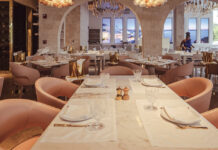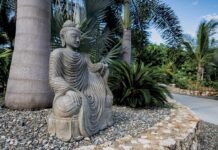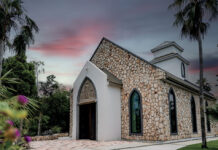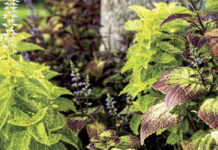InsideOut explores traditional West Indian architecture as a means to help regulate the temperature of your home.
Only a couple of generations ago, air conditioning was virtually unknown in the Cayman Islands, with shutters to keep the house cool and smoke-pots to ward off mosquitoes.
Times have changed rapidly and nearly every home and office now enjoys the benefits of AC, but there is much to be learned from traditional architecture – and it can even help save you money in the long term.
“In the earliest times, before glass and windows, Cayman homes would have had solid wood shutters which provided protection during stormy times and also at night the house would be closed shut to keep out the mosquitoes,” explains architect John Doak. “In later years, sacking, smoke-pots and, eventually, fly screening would protect inhabitants from the pesky bugs.
”Louvred shutters on the outside of the home, or plantation shutters on the inside, allow the user to control the amount of daylight inside. The filtration of light (and heat) is both a science and a major part of the art of Caribbean home design.
“Over the centuries, architects and builders have experimented with endless configurations for trellises, louvres and gingerbreading to provide functional cooling devices or simply for decorative embellishment.
“Inside the house, doors helped provide privacy, often fully louvred to still allow the breeze to pass through. Hot air rises, so above the doors and at the top of some interior walls, were trellised or louvred transoms where the breeze could still pass over from room to room.
“In Cayman there were no rivers or mountains, so using lakes or running water as a means to further cool the breezes didn’t happen here. Homes along the shoreline do benefit from the reduced air temperature that the ocean water provides, especially in the winter time when the Christmas breeze is prevalent.
“Setting a house high upon a cliff or hilltop allows the home to benefit most from available breezes. It also provides views from the home and additional safety in times of storm surge or flooding. Steep sloping roofs allow the air to exit the roof space quicker and also the rain runs off more efficiently and ceiling fans help to move the air and provide cooling.”
John Doak has drawn on traditional West Indian architectural techniques and designs to embrace these elements for contemporary homes.
“The buildings and places we create at John Doak Architecture are at home in the tropics and speak to the place where we reside,” he says.
“For the majority of our residences we tend to perpetuate traditional construction techniques and engage Cayman Islands labour and expertise.
“Most materials can be locally procured or obtained from suppliers in Miami or Tampa. Whilst our designs respect local building traditions we continue to explore new materials, construction methods and renewable energy systems. We are not obsessively ‘green’ but we do understand how to design buildings that are entirely suitable and sustainable in a tropical environment.”
Doak cites the term “eco-friendly” as a buzzword for making sensible choices for materials and methods for construction in an environment where Mother Nature isn’t always friendly.
“Building in the tropics and on remote islands necessitates a sustainable approach so, for us, it’s not a trend but rather it’s the way we’ve always designed and built in these parts,” he says.
Modern methods
Doak points out that in the tropics there are many aspects of the natural environment to consider when building, including the sun’s intense and often relentless heat. There is also the brightness of the sunlight, the easterly breezes which in the summer can reach hurricane-force winds, the corrosive effects of the salty air, and the rainy season from June through September as well as dry periods.
“So beyond positioning a building to enjoy the views to the ocean and the orientation of the house to capture the breezes, the design and building of any residence in the tropics should address shading from the rain and sun, and the use of shadows,” he says.
“Also filtration of light and/or the reflection of the heat and sunlight, hurricane storm protection, earthquake resistance, lightning protection, longevity of materials to resist decay and corrosion, along with the need to understand the logistics of building in a location that may have local labour and expertise limitations.”
With soaring energy prices, as well as a trend towards natural living, it can make sense to incorporate aspects of traditional architecture into new-builds or adapt your existing residence in Cayman.
“Consider the orientation of your home,” says Doak. “Which direction is north? Where does the breeze generally come from – (it’s usually from the east to northeast in Cayman)? Which direction is east, where does the sun rise and where does the sun set each evening?
“Consider ways you can welcome the breeze into your house or across a porch. This might mean modifying your landscaping to funnel the breeze across your yard.
“Shade the southern side of the house so that you reduce the heat and glare on the interior of your home. Do you need to insulate the roof or the walls? Sometimes it is easier to ‘outsulate’ by affixing rigid foam on the exterior of the house and then putting stucco over it as a finish.”
Doak suggests incorporating traditional architecture features as a long-term investment.
“There needs to be a mindset change before you’ll see a change in the fuel bills,” he says. “Rather like a diet and weight loss programme, you have to be committed to participate. A lot of people enjoy the creature comforts of air conditioning and develop less and less appreciation for fresh air and a natural cooling breeze.
“Throw open the doors and windows and feel the freshness, welcome the aroma of the plants and trees, the sound of the wind in the leaves, the taste of the air. Breathe in the air, appreciate that stimulation of all your senses. That’s the true, and healthy, bonus to whatever saving you might actually make on your power bill at CUC.”






























